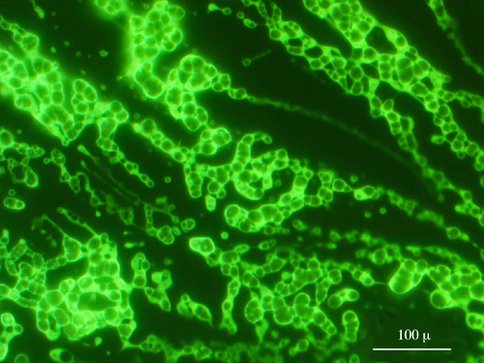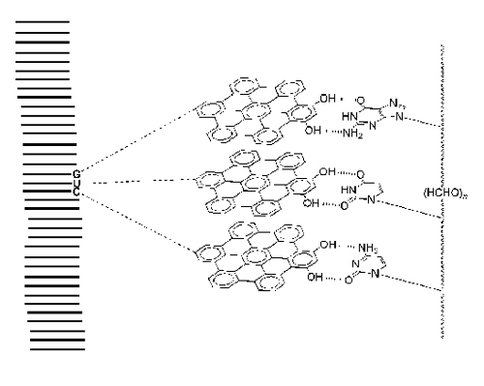2007 Annual Science Report
 Carnegie Institution of Washington
Reporting | JUL 2006 – JUN 2007
Carnegie Institution of Washington
Reporting | JUL 2006 – JUN 2007
Project 4. Prebiotic Molecular Selection and Organization
Project Summary
Project Progress
1. Molecular Self-Organization
Studies in molecular self-organization continued to focus on amphiphilic molecules, which are molecules that possess both hydrophobic and hydrophilic regions. These molecules tend to self-organize spontaneously in an aqueous environment (Figure 1). Co-Investigators Robert Hazen and David Deamer continued their investigations of suites of molecules produced when an aqueous solution of pyruvate is subjected to hydrothermal conditions (250oC at 0.2 GPa). Their efforts involved identification of the lipid-like molecules that form vesicles in water.
Deamer and coworkers also studied the abiotic formation of aliphatic lipid compounds (i.e., fatty acids, alcohols, and acylglycerols) as has been reported to occur at elevated temperatures and pressures under simulated hydrothermal conditions. Although abiotic synthetic chemistry can occur under these conditions, the prebiotic self-assembly of micelles to bilayer to vesicles (protocells) may have occurred elsewhere. Because they are abundant products of Fischer-Tropsch-type reactions and are also present in the organic components of carbonaceous meteorites, amphiphilic compounds such as fatty acids are important candidates for micelle/bilayer/vesicle formation. Thus, it is of interest to determine whether more complex amphiphilic precursor compounds capable of assembling into stable membrane structures can be synthesized under hydrothermal conditions. Hydrothermal experiments were conducted to study condensation reactions of model lipid precursors in aqueous media to form acylglycerols (glyceryl alkanoates) at elevated temperature under confining pressure. Nine different alkanoic acids ranging from C7 to C16 (except C8) were used in these experiments. The condensation products were two isomers each of monoacylglycerols and diacylglycerols, as well as the corresponding triacylglycerol. The results indicated that (1) condensation (dehydration) reactions are possible under aqueous pyrolysis conditions, (2) abiotic synthesis and subsequent condensation reactions of aliphatic lipid compounds are possible under hydrothermal conditions, and (3) such molecules have robust properties of self-assembly into membranous structures that would be suitable boundary structures for primitive forms of cellular life.
Postdoctoral Fellow Nicholas Platts continued to develop the “PAH world” model of life’s origins, based on the discotic self-organization of functionalized polycyclic aromatic hydrocarbon (PAH) molecules in an aqueous environment. In this model, a stack of PAHs becomes decorated at the edges with the bases of nucleic acids (Figure 2), which are linked into a genetic-type sequence. Platts proposes this model as a precursor to the RNA world.
2. Molecular Selection and Organization on Mineral Surfaces
Studies in molecular selection focused on problems related to which molecules are adsorbed selectively onto given mineral surfaces. The group’s first task has been to identify general trends in molecular adsorption on minerals. To this end, Postdoctoral Fellow H. James Cleaves initiated an ambitious program of “geochromatography,” which is the study of the differential adsorption of molecular mixtures onto polycrystalline rocks and minerals. Preliminary results demonstrate pronounced selective adsorption of molecules in a complex suite of HCN polymers. The group is also studying mixtures of sugars (including the pentose sugar ribose and its isomers), as well as mixtures of amino acids and carboxylic acids. They find that adsorption is dominated to first order by electrostatic effects, but numerous more subtle stereochemical effects also come into play.
Given the vast numbers of different mineral surfaces and different organic molecules of interest, a combinatoric approach is needed. Therefore, Collaborator Jake Maule and Co-Investigators Andrew Steele, Edward Vicenzi, and Hazen have continued to focus on the application of microarray technologies to apply small amounts of many different molecules to several different mineral surfaces in a single experiment. Their principal objective is to refine procedures, both in printing arrays and in analyzing those arrays using time-of-flight secondary ion mass spectrometry, or ToF-SIMS.
In addition to these studies of chiral selection, Collaborator GÖzen Ertem continued studies of the formation of RNA oligomers on Na-montmorillonite (a clay mineral). She has demonstrated the formation of phosphodiester bonds in the presence of this clay. Furthermore, she finds that the rates of formation of different A-C trimers differ significantly (Table 1). Thus, only a limited number of oligomers could have formed on the early Earth, rather than equal amounts of all possible isomers.
| % Yield | Isomer | RNase T2 products | APH Products |
|
| 1 | 1.2 | C2’pC2’pC | C2’pC2’pC | C2’pC2’pC |
| 2 | 1.1 and/or 3.1 |
C2’pA2’pC C2’pC2’pA A2’pC2’pC |
C2’pA2’pC C2’pC2’pA A2’pC2’pC |
C2’pA2’pC C2’pC2’pA A2’pC2’pC |
| 3 | 3.4 | A2’pA2’pC | A2’pA2’pC | A2’pA2’pC |
| 4 | 6.7 5.6 |
C3’pA2’pC A2’pC3’pC | C3’p + A2’pC A2’pC3’p + C | C + A2’pC A2’pC + C |
| 5 | 2.7 | A2’pA2’pA | A2’pA2’pA | A2’pA2’pA |
| 6 | 2.5 | C3’pA3’pC | C3’p+A3’p + C | C + A + C |
| 7 | 2.8 | A2’pA3’pA | A22’pA3’p + A | A2’pA +A |
| 8 | 10 | A3’ pC2’pC | A3’ p + C2’pC | A + C2’pC |
| 9 | 4.4 | A3’pC3’pC | A3’p +C3’p + C | A + C + C |
| 10 | 26 | A3’pA2’pC | A3’p + A2’pC | A + A2’pC |
| 11 | 3.9 | A3’pC3’pA | A3’p C3’p A | A + C + A |
| 12 | 9.5 | A3’pA3’pC | A3’p+ A3’p+ C | A + A + C |
| 13 | 1.5 | A3’pA2’pA | A3’p + A2’pA | A + A2’pA |
| 14 | 1.3 | A3’pA3’pA | A3’p A3’p A | A + A + A |
| 14 | Other isomers |
Table 1. Montmorillonite catalyzes the formation of RNA oligomers in a non-random way. Of the 32 different A-C trimers (with either 3’ or 2’ linkages), the four trimers with AAC sequence account for almost 50% of all sequences, whereas CCC and CCA sequences represent less than 5% of all observed trimers.
-
PROJECT INVESTIGATORS:
-
PROJECT MEMBERS:
David Deamer
Co-Investigator
Andrew Steele
Co-Investigator
Ed Vicenzi
Co-Investigator
Gözen Ertem
Collaborator
Jake Maule
Collaborator
Antonio Salgado
Collaborator
Dimitri Sverjensky
Collaborator
Henderson Cleaves
Postdoc
Simon Platts
Postdoc
Matthieu Galvez
Doctoral Student
-
RELATED OBJECTIVES:
Objective 3.1
Sources of prebiotic materials and catalysts
Objective 3.2
Origins and evolution of functional biomolecules
Objective 3.4
Origins of cellularity and protobiological systems
Objective 4.1
Earth's early biosphere
Objective 7.1
Biosignatures to be sought in Solar System materials



